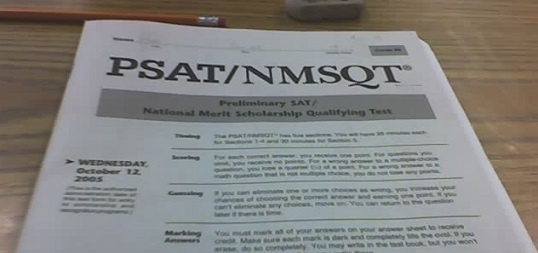
Have you heard about the PSAT or the National Merit program and are wondering what they are? Are you looking for ways to prepare for the SAT?
Read this guide to learn what the PSAT/NMSQT is, what it tests, and how it can get you ready for the SAT and earn you money for college.
What Is the PSAT/NMSQT?
First of all, what do all those letters stand for? The full name is the Preliminary SAT/National Merit Scholarship Qualifying Test, often abbreviated to PSAT. So what is the PSAT? It's a standardized test that 10th and 11th graders can take, and about 3.5 million students choose to take it each year.
The PSAT is used to determine eligibility and qualification for the National Merit Scholarship Program (which is what the "NMSQT" part of the name is for). It also serves as a practice test for the SAT, but be aware that you can't submit PSAT scores to colleges as your standardized test scores.
What Sections Does the PSAT/NMSQT Include?
The structure and content of the PSAT have been recently revised to reflect changes made to the SAT. There are three sections on the PSAT: Math, Reading, and Language and Writing. The total testing time of the PSAT is 2 hours and 45 minutes, and it includes 139 questions. This information is broken down more specifically below.
Reading Section: 60 minutes to answer 47 questions
Writing and Language Section: 35 minutes to answer 44 questions
Math Section: 70 minutes to answer 48 questions
What Material Do These Sections Cover?
Reading Section
The reading section tests students' ability to draw conclusions and make inferences from reading passages. The 47 questions are based on three passages and two passage pairs (a passage pair is when a passage is paired with a chart, table, graph, or other passage, and the questions use information from both of those sources).
The five passages/passage pairs will cover the following subjects:
- 1 on US/World Literature (with 9 corresponding questions)
- 2 on Social Studies/History (with 18-20 corresponding questions)
- 2 on Science (with 18-20 corresponding questions)
Writing and Language Section
The Writing and Language Section tests knowledge of grammar, usage, punctuation, and other English conventions. It does not include an essay. There are four passages/passage pairs in this section which address topics related to careers, history/social studies, the humanities, and science.
There are two categories of question in this section:
- 24 questions on Expression of Ideas
- 20 questions on Standard English Conventions

Math Section
The Math Section focuses on algebraic problems and tests ability to analyze and interpret data sets. For the first 25 minutes, a calculator is not allowed, but students are allowed to use a calculator for the last 45 minutes of the section. The questions are mostly multiple choice, but some (17-22%) will have grid-in answers.
The topics tested in this section are:
- Heart of Algebra (linear equations and systems)
- Problem Solving and Data Analysis (quantitative literacy)
- Passport to Advanced Math (manipulation of complex equations)
- Additional Topics in Math (geometric and trigonometric skills)
How Is the PSAT/NMSQT Scored?
The PSAT has recently implemented a new scoring system. As of 2015, the score range has been changed, and there will no longer be deductions for incorrect answers. Although the PSAT/NMSQT has a shared common score scale as the SAT, score ranges are not identical. The PSAT's total score range is 320-1520.
The PSAT's range doesn't go up to 1600 like the SAT's does because the PSAT is a less difficult test than the SAT, and since a perfect score on the PSAT does not necessarily indicate a perfect score on the SAT, having identical score ranges may have caused some test takers to mistakenly believe that.
There are two main section scores for the PSAT: the Math Score and the Evidence-Based Reading and Writing Score. Both of these sections have score ranges of 160-760. The Evidence-Based Reading and Writing Score is based on the combined scores of the Language and Writing and the Reading sections. This means that the Math section accounts for half of your entire PSAT score.
The PSAT also has three test scores for each of the three subject sections, Math, Reading, and Language and Writing, that range from 8-38. Additionally, within each of these three sections there are several subsections with scores ranging from 1-15. These subscores let exam takers see how well they scored in more specific areas and can help make future studying more effective.
There are seven subscores in the following categories:
Reading: Command of Evidence, Words in Context
Writing and Language: Expression of Ideas, Standard English Conventions
Math: Heart of Algebra, Problem Solving and Data Analysis, Passport to Advanced Math
What Are the Benefits of the PSAT/NMSQT?
How can taking the PSAT help you? There are three main ways:
1. Practice for the SAT
The PSAT allows you practice taking a test very similar to the SAT, under real test conditions. It can give you an estimate of the score you'd get on the SAT, and you can also look at the section scores and subscores to see which areas you should study the most in the future.

The PSAT is a great way to practice for the SAT and other standardized tests
2. Practice for Standardized Tests in General
Even though the PSAT will prepare you most directly for the SAT, taking it can benefit anyone looking to get more practice taking other standardized tests, like the ACT. It can help you practice managing your time during a test, improve your critical thinking skills, and also give you an opportunity to see how well you do under official testing conditions.
3. Potential for Scholarship Money
Competition is tough, but students with top PSAT scores can get a significant amount of scholarship money. Of the roughly 1.5 million high school juniors who take the test, about 50,000 students with the highest total PSAT/NMSQT scores qualify for recognition in the National Merit Scholarship Program. About 34,000 of those students become Commended Scholars. The roughly 16,000 students with the highest PSAT scores in the country (partly based on which state you live in) become National Merit Semi-Finalists, and most of them (about 15,000) move on to become National Merit Finalists.
Over $180 million in scholarship money is awarded annually to students who get high scores on the PSAT. About half of the National Merit Finalists receive a $2,500 National Merit Scholarship, renewable for up to four years. Many corporations offer scholarship money as well. In addition, many colleges offer scholarships to National Merit Commended Scholars, Semi-Finalists, and Finalists. Some schools even offer a tuition waiver, which can save you tens of thousands of dollars.
If you're interested in learning more about the National Merit Scholarship program, check out our guide which provides tips to help you improve your chances of becoming a Semi-Finalist!

Getting a National Merit Scholarship can really fill up your piggy bank
Want to improve your PSAT score by 150 points? We have the industry's leading PSAT prep program. Built by Harvard grads and SAT full scorers, the program learns your strengths and weaknesses through advanced statistics, then customizes your prep program to you so that you get the most effective prep possible.
Check out our 5-day free trial today:
Who Should Take the PSAT/NMSQT?
There are multiple groups who can benefit from taking the PSAT. This can include high school sophomores or juniors looking to get more practice for the SAT, especially under real test conditions, as well as students who want more practice taking standardized tests in general.
If you are trying to decide between the SAT and the ACT, taking the PSAT may also helpful because you can get an estimate of your SAT score without worrying about it being sent to colleges if it is lower than you'd like.
Juniors who are confident in their standardized test-taking abilities and want to try for National Merit recognition and scholarships should also consider taking the PSAT, as well as sophomores hoping to increase their chances of winning a scholarship next year by getting more PSAT practice.
How Do You Sign Up for the PSAT/NMSQT?
The PSAT is administered by high schools, so you will register through your school. The PSAT is taken in October of your junior year.
You can also take the exam as a sophomore, however; you won’t be eligible for National Merit awards that year. There is also a test called the PSAT10, which is offered only for 10th graders in the spring. This is the same test as the PSAT/NMSQT, but it is for preparation purposes only and is not part of the National Merit Scholarship Program. Students who take the PSAT 10 in the spring can still take the PSAT/NMSQT in the fall.
What's Next?
Have you decided to take the PSAT and want to know how to prepare for it? Take a look at this guide to finding full-length PSAT tests and practice questions!
Not a high school junior yet? Take a look at our guide to the PSAT 10, which is specially designed for sophomores.
Interested in winning a National Merit Scholarship? We have a guide that gives step-by-step instructions to improving your chances!
Want to improve your SAT score by 160 points or your ACT score by 4 points? We've written a guide for each test about the top 5 strategies you must be using to have a shot at improving your score. Download it for free now:
Have friends who also need help with test prep? Share this article!

Christine graduated from Michigan State University with degrees in Environmental Biology and Geography and received her Master's from Duke University. In high school she scored in the 99th percentile on the SAT and was named a National Merit Finalist. She has taught English and biology in several countries.




































 Holly R.
Holly R.